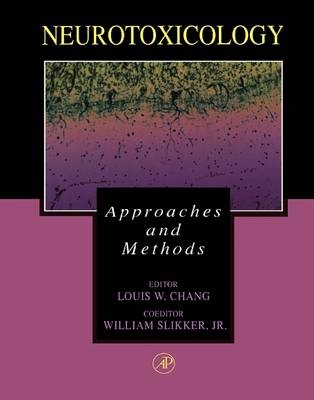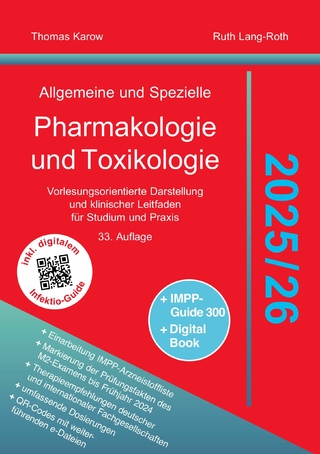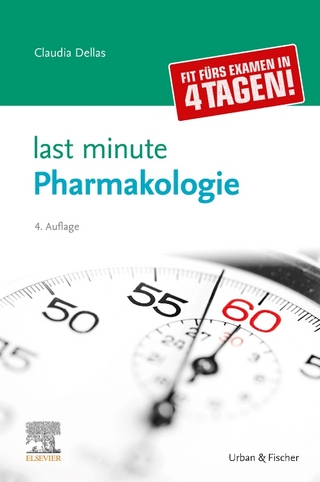
Neurotoxicology
Academic Press Inc (Verlag)
978-0-12-168055-8 (ISBN)
Neurotoxicology: Approaches and Methods provides a unique and comprehensive presentation of the current concepts and state-of-the-art methods for the assessment of neurotoxicity. The book analyzes various techniques available and discusses their strengths and weaknesses. This volume will serve as an excellent desk companion and laboratory guide for all investigators, researchers, clinicians, and students interested in neurotoxicology. The internationally knowngroup of editors divide the book into seven sections: Neuromorphological and Neuropathological Approaches; Neurophysiological Approaches; Neurobehavioral Toxicology; Neurochemical and Biomolecular Approaches; In-Vitro Models; Clinical Neurotoxicology; and Risk Assessment of Neurotoxicity. Each section yields the most up-to-date information by experts in their fields. Meticulously organized and edited, Neurotoxicology: Approaches and Methods is the most authoritative and well-planned neurotoxicology book on the market.
Louis W. Chang is a Professor in the Departments of Pathology, Pharmacology, and Toxicology at the University of Arkansas for Medical Sciences. He also served as the Director of the Toxicology Program and is the current Graduate Director of the Pathology Program in Arkansas. Aside from being the author of over 200 scientific articles, Dr. Chang also served on the editorial boards for a number of publications and scientific journals in his field. He is a well recognized scientist internationally. Dr. Chang has been recently elected as a Fellow of the Academy of Toxicological Sciences and has become a board certified Diplomate of the American Board of Forensic Examiners and a Diplomate of the American Board of Forensic Medicine. He received his B.A. from the University of Massachusetts, Amherst, his M.S. in Anatomy and Histochemistry from the Tufts University School of Medicine, and his Ph.D. in Pathology from the University of Wisconsin, Madison Medical School. Dr. Chang also received education and training from Harvard Medical School and the University of California, Los Angeles School of Medicine. Dr. William Slikker, Jr. was the director of FDA’s National Center for Toxicological Research (NCTR) before his retirement. He received his Ph.D. in pharmacology and toxicology from the University of California at Davis. Dr. Slikker holds adjunct professorships in the Department of Pediatrics, as well as the Department of Pharmacology and Toxicology at the University of Arkansas for Medical Sciences. He has held committee chairmanships or elected offices in several scientific societies including the Teratology Society (serving as president) and the American Society for Pharmacology and Experimental Therapeutics (chair, Developmental Pharmacology Section and member, Program Committee). Dr. Slikker is also the co-founder and past president of the MidSouth Computational Biology and Bioinformatics Society. He is currently associate editor for NeuroToxicology and associate editor for the “Environmental Health section of Experimental Biology and Medicine. He is the past president of The Academy of Toxicological Sciences and the Society of Toxicology. He is a recipient of the 2014 George H. Scott Memorial Award from The Toxicology Forum and was invited to present the Warkany Lecture at the 2015 annual meeting of the Teratology Society. In early 2019, the Academy of Toxicological Sciences selected Dr. Slikker to receive the prestigious Mildred S. Christian Career Achievement Award. The Society for Birth Defects Research and Prevention selected Dr. Slikker to be the recipient of the 2022 Edward W. Carney Distinguished Service Award. Dr. Slikker has authored or co-authored over 380 publications in the areas of transplancentalpharmacokinetics, developmental neurotoxicology, neuroprotection, systems biology, and risk assessment. Dr. Slikker’s recent research has highlighted the concern for thousands of infants and toddlers who undergo longer-duration general anesthesia. He has performed research with his team and published over 25 peer-reviewed papers outlining the issue of brain-cell death and cognitive-function deficits in animal models that may result from several hours of anesthesia at a critical time of development. He has also, with the use of in vitro and in vivo techniques in rodents and nonhuman primates, defined possible mechanisms of toxicity and protective pathways to prevent the detrimental effects of general anesthesia. Through these and related scientific contributions, he has identified and characterized a host of minimally invasive biomarkers of neurotoxicity including the use of preclinical imaging (MRI, MicroPET/CT), genomic and lipidomic analysis, and modeling approaches to characterize and quantify adult and developmental neurotoxicity. He has also served on several national/international advisory panels for ILSI, HESI, CIIT, EPA, NIEHS, NAS, NIH and WHO.
ANIMAL MODELS: NEUROMORPHOLOGICAL and NEUROPATHOLOGICAL APPROACHS: Introductory Overview. Selected Histopathological and Histochemical Methods for Neurotoxicity Assessment. Neuroanatomical Techniques for Labeling Neurons and Their Utility in Neurotoxicology. Enzyme Histochemical Methods. Ultrastructural Methods for Neurotoxicology and Neuropathology. Quantitative Morphometry for Neurotoxicity Assessment. NEUROPHYSIOLOGICAL APPROACHES and METHODS: Introductory Overview. Electrophysiological Analysis of Ion Channel Function. Electrophysiological Methods for Analysis of Effects of Neurotoxicants on Synaptic Transmission. Hippocampal Field Potentials: A Model System to Characterize Neurotoxicity. Electrophysiological Analysis of Complex Brain Systems: Sensory Evoked Potentials and Their Generators. NEUROBEHAVIORAL TOXICOLOGY: Introductory Overview. Behavioral Screening Tests: P, P, & F. Neurobehavioral Methods for the Evaluation of Sensory Functions. Motor Function and the Physical Properties of the Operant: Applications to Screening and Advanced Techniques. Approaches to Utilizing Aspects of Cognitive Function as Indicator of Neurotoxicity. Use of Drug Discrimination Learning in Behavioral Toxicology: Classification and Characterization of Toxins. Extrapolating Scientific Data from Animals to Humans in Behavioral Toxicology and Behavioral Pharmacology. Role of Dopaminergic and Glutametergic Neurotransmitter Systems in Lead-Induced Learning Impairments. Dopaminergic Bases of Polychlorinated Biphenyl-Induced Neurotoxicity. Bases of Excitatory Amino Acid System-Related Neurotoxicity. NEUROCHEMICAL and BIOMOLECULAR APPROACHES: Introductory Overview. Basic Biochemical Approaches in Neurotoxicity: Assessment of Neurotransmitters and Neuroreceptors. Biomolecular Approaches to Neurotoxic Hazard Assessment. Nucleic Acid Hybridization Techniques and Neurotoxicity Assessment. Application of the Technique of Brain Microdialysis in Determining the Mechanisms of Action of Neurotoxicants. Combined Electrical Resistance Method for Cell Volume Measurement and Continuous Perfusion for the Measurement of the Release of Endogenous Substances: An in VITRO Assay for Cytotoxicity. Selective Techniques Designed to Evaluate Neurotoxicity: Electron Probe X-Ray Microanalysis as a Tool for Discerning Mechanisms of Nerve Injury. Glutamate Receptor-Mediated Neurotoxicity. Assessment of Neurotoxicity Via Chemical Purturbation of Oxonal Transport. Disruption of Energy Metabolism and Mitochondrial Function. In VITRO MODELS: IN-VITRO Toxicology: Introductory Overview. Strategic Approaches to in VITRO Neurotoxicology. The Use of Serum-Free Aggregating Brain Cell Cultures in Neurotoxicology. Brain Slice Techniques in Neurotoxicology. Cell Suspension Techniques in Neurotoxicology. Central Nervous System Glial Cell Cultures for Neurotoxicological Investigations. Neurotoxicology Studies Utilizing Schwann Cell-Neuronal Interactions in VITRO. Organotypic Cultures of Mammalian Nerve Tissues: A Model System for Neurotoxicological Investigation. Human Neuronal Cell Lines and in VITRO Models. In VITRO Systems for the Investigation of Calcium Homeostasis and Calcium-Induced Cell Damage. In VITRO Electrophysiological Studies in Neurotoxicology. CLINICAL NEUROTOXICOLOGY: Clinical Neurotoxicology: An Introductory Overview. Basic Principles of Clinical Neurotoxicology. Clinical Neurotoxicology of Industrial and Agricultural Chemicals. Clincial Neurotoxicological Concerns on Drugs of Abuse. Clinical Neurotoxic Concerns on Antineoplastic Agents. Neurotoxins and Neurodegenerative Diseases. Clinical Approaches to Neurotoxicology: An Overview. The Recognition and Differentiation of Neurotoxic and Non-Neurotoxic Syndromes. Exposure Assessment in Clinical Neurotoxicology: Environmental Monitoring and Biologic Markers. Clinico-Neuropsychological Assessment Methods in Behavioral Neurotoxicology. Behavioral Neurophysiology: Quantitative Measures of Sensory Toxicity. Electrophysiological Investigations of Toxic Neuropathies. Evoked Potential Testing in Clinical Neurotoxicology. Neuroimaging in Neurotoxicology. RISK ASSESSMENT for NEUROTOXICITY: Neurotoxicology Risk Assessment: An Overview. Concepts on Quantitative Risk Assessment of Neurotoxicants. Quantitative Approaches to Risk Assessment in Neurotoxicology. Use of Biological Markers in the Quantitative Assessment of Neurotoxic Risk. Developmental Neurotoxicology Risk Assessment. Unique Dimensions of Neurotoxic Risk Assessment.
| Erscheint lt. Verlag | 20.4.1995 |
|---|---|
| Verlagsort | San Diego |
| Sprache | englisch |
| Maße | 152 x 229 mm |
| Gewicht | 2230 g |
| Themenwelt | Studium ► 2. Studienabschnitt (Klinik) ► Pharmakologie / Toxikologie |
| Naturwissenschaften ► Biologie ► Biochemie | |
| Naturwissenschaften ► Biologie ► Zoologie | |
| ISBN-10 | 0-12-168055-X / 012168055X |
| ISBN-13 | 978-0-12-168055-8 / 9780121680558 |
| Zustand | Neuware |
| Haben Sie eine Frage zum Produkt? |
aus dem Bereich


